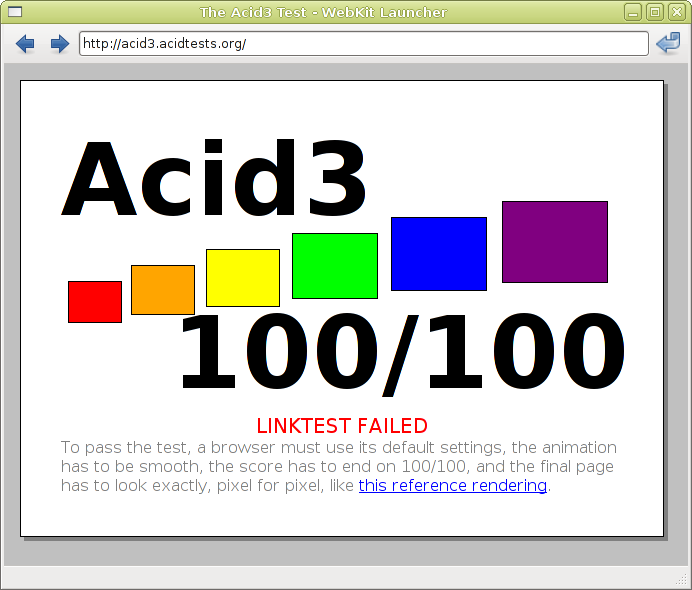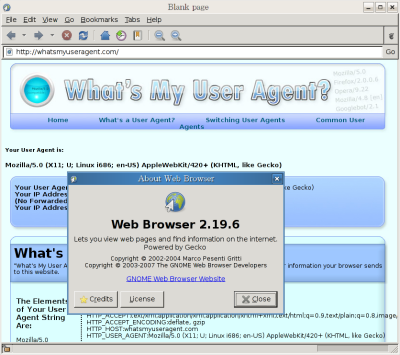 I already mentioned a few
times in the blog
I already mentioned a few
times in the blog that I’m working on a
Debian package of the
Conkeror web browser. And now, after a lot of fine-tuning (and I still
further new ideas how to improve the package ;-)
Conkeror is finally in the NEW queue and hopefully will hit
unstable in a few days. (Update Thursday, 03-Jul-2008, 18:13
CEST: The package has been accepted by Jörg and should be
included on most architectures in tonight’s updates.)
Those who could hardly await it can fetch Conkeror .debs from
http://noone.org/debian/. The
conkeror package itself is a non-architecture specific package (but
needs xulrunner-1.9 to be available), and its small C-written helper
program spawn-process-helper is available as package
conkeror-spawn-process-helper for i386, amd64, sparc, alpha, powerpc,
kfreebsd-i386 and kfreebsd-amd64. There are no backported packages for
Etch available, though, since I don’t know of anyone yet, who has
successfully backported xulrunner-1.9 to Etch.
Interestingly the interest in Conkeror seems to have risen in the
Debian community independently of its Debian packaging.
Luca Capello, who sponsored
the upload of my Conkeror package, pointed me to two
blog post on
Planet Debian, written by people being fed up with
Firefox 3 already
and are looking for a more lean, but still Gecko based web browser:
Decklin Foster is fed up with Firefox’ -eh- Iceweasel’s
arrogance and
MJ Ray is fed up with Firefox 3 and its SSL problems.
Since my previously favourited Gecko based web browser
Kazehakase
never became really stable but instead became slow and leaking memory
(and therefore not much better than Firefox 2), I can imagine that
it’s no more an candidate for people seaking for a lean and fast web
browser.
Conkeror has some “strange” concepts of which the primary one is that
it looks and feels like
Emacs:
-
The current location is shown in a status bar below the website, where
Emacs usually shows buffer names. All input, even entering new URLs to
go to, is done via the mini-buffer, an input line below the status
bar.
-
Instead of tabs it uses Emacs’ concept of buffers. So no tab bar
clutter and though easy access to all currently open pages.
-
It has no buttons, menu-bar or such. And except the status bar and
mini-buffer, it uses the whole size of the window for the displayed
web page. This is the main reason why I prefer Conkeror on the 7”
EeePC: I don’t want to waste any pixels for buttons or menu bars and
still have a fully functional web browser.
-
It of course has Emacs alike keybindings (with a slight touch of
Lynx). While this may seem awkward for the vi world (Hey, they have
the vimperator*, also in Debian since a
few days!), as an Emacs user you just have to remember that you web
browser now also expects to be treated like an Emacs. It just works:
C-x C-c- Exit Emacs -eh- Conkeror
C-x C-f- Open File -eh- web page in new buffer
C-x C-b- Change to some other tab -eh- buffer
C-x C-v- Replace web page in this buffer and use the current URL as start for entering the new one
C-x 5 2- Open new frame -eh- window
C-x 5 0- Close current frame -eh- window
C-x k- Close tab, -eh- kill buffer
C-h i- Documentation
C-s- Incremental search forward
C-r- Incremental search backward
C-g- Stop
l- Go back (Think info-mode)
g- Go to (Open web page in this buffer)
(Hehe, I like the faces of vi users having read these keybindings and
now wondering how to remember them. SCNR. Well, sometimes vi
key bindings are a mystery to me, too. :-)
There are of course many more and nearly all are the same as in Emacs,
even the universal argument C-u and the M-x
command-line are there. E.g. C-u g lets you open a web
page in a new buffer, too.
-
Conkeror also has very promising concept for following and copying
links with the keyboard only. Opera is very inefficient here since you
have to jump from link to link to get to the one you want. In Conkeror
you just press
f for following or c for
copying links and then all links on the currently shown part of the
page show a small number attached to it. Then you just enter the
number (and additionally press enter if the number is ambigous) and
the link is either opened or copied to the clipboard.
A funny anecdote about how this concept grew over the time: Early
versions of Conkeror (back in the days when it just was a Firefox
externsion as vimperator) numbered all links on the page, not
only the visible ones. On large pages with many links or buttons (e.g.
my blog ;-), this took minutes to complete. The idea to just number
the visible links is so simple and important – but someone first
needed to have it. :-)
Footnotes
*) I just noticed that there is now also
muttator, making
Thunderbird look and behave like vim (and probably also
mutt), too.
Wonder into which e-mail client the Emacs community will convert
Thunderbird. GNUS? RMAIL?
VM? Wanderslust? What will it be called?
Wunderbird? Thunderslust? (SCNRE ;-)
 I already mentioned a few
times in the blog that I’m working on a Debian package of the
Conkeror web browser. And now, after a lot of fine-tuning (and I still
further new ideas how to improve the package ;-) Conkeror is finally in the NEW queue and hopefully will hit
unstable in a few days. (Update Thursday, 03-Jul-2008, 18:13
CEST: The package has been accepted by Jörg and should be
included on most architectures in tonight’s updates.)
Those who could hardly await it can fetch Conkeror .debs from http://noone.org/debian/. The
conkeror package itself is a non-architecture specific package (but
needs xulrunner-1.9 to be available), and its small C-written helper
program spawn-process-helper is available as package
conkeror-spawn-process-helper for i386, amd64, sparc, alpha, powerpc,
kfreebsd-i386 and kfreebsd-amd64. There are no backported packages for
Etch available, though, since I don’t know of anyone yet, who has
successfully backported xulrunner-1.9 to Etch.
Interestingly the interest in Conkeror seems to have risen in the
Debian community independently of its Debian packaging. Luca Capello, who sponsored
the upload of my Conkeror package, pointed me to two blog post on
Planet Debian, written by people being fed up with Firefox 3 already
and are looking for a more lean, but still Gecko based web browser: Decklin Foster is fed up with Firefox’ -eh- Iceweasel’s
arrogance and MJ Ray is fed up with Firefox 3 and its SSL problems.
Since my previously favourited Gecko based web browser Kazehakase
never became really stable but instead became slow and leaking memory
(and therefore not much better than Firefox 2), I can imagine that
it’s no more an candidate for people seaking for a lean and fast web
browser.
Conkeror has some “strange” concepts of which the primary one is that
it looks and feels like Emacs:
I already mentioned a few
times in the blog that I’m working on a Debian package of the
Conkeror web browser. And now, after a lot of fine-tuning (and I still
further new ideas how to improve the package ;-) Conkeror is finally in the NEW queue and hopefully will hit
unstable in a few days. (Update Thursday, 03-Jul-2008, 18:13
CEST: The package has been accepted by Jörg and should be
included on most architectures in tonight’s updates.)
Those who could hardly await it can fetch Conkeror .debs from http://noone.org/debian/. The
conkeror package itself is a non-architecture specific package (but
needs xulrunner-1.9 to be available), and its small C-written helper
program spawn-process-helper is available as package
conkeror-spawn-process-helper for i386, amd64, sparc, alpha, powerpc,
kfreebsd-i386 and kfreebsd-amd64. There are no backported packages for
Etch available, though, since I don’t know of anyone yet, who has
successfully backported xulrunner-1.9 to Etch.
Interestingly the interest in Conkeror seems to have risen in the
Debian community independently of its Debian packaging. Luca Capello, who sponsored
the upload of my Conkeror package, pointed me to two blog post on
Planet Debian, written by people being fed up with Firefox 3 already
and are looking for a more lean, but still Gecko based web browser: Decklin Foster is fed up with Firefox’ -eh- Iceweasel’s
arrogance and MJ Ray is fed up with Firefox 3 and its SSL problems.
Since my previously favourited Gecko based web browser Kazehakase
never became really stable but instead became slow and leaking memory
(and therefore not much better than Firefox 2), I can imagine that
it’s no more an candidate for people seaking for a lean and fast web
browser.
Conkeror has some “strange” concepts of which the primary one is that
it looks and feels like Emacs:
 Well, I was hoping to get Yet Another Blog Reorg
done before posting this, but it just hasn't
happened, so here are a few more thoughts on
Firefox 3 on this ol' blog.
In fact, I'll probably finish the FF3 series here
before I switch over.
I was in central London on Tuesday and suffered both
Well, I was hoping to get Yet Another Blog Reorg
done before posting this, but it just hasn't
happened, so here are a few more thoughts on
Firefox 3 on this ol' blog.
In fact, I'll probably finish the FF3 series here
before I switch over.
I was in central London on Tuesday and suffered both

 Instead of trying to set a world record in the most stupid world record ever category, finally bringing software development to the same level as
Instead of trying to set a world record in the most stupid world record ever category, finally bringing software development to the same level as 
 My thesis is about data mining, clustering of correlated data in high
dimensional vector spaces, to be a bit more precise.In detail, I'm working on methods to improve upon existing clustering
algorithms such as
My thesis is about data mining, clustering of correlated data in high
dimensional vector spaces, to be a bit more precise.In detail, I'm working on methods to improve upon existing clustering
algorithms such as  Hello World,
a tape streamer of one of our customers died two days ago and we haven’t anymore warranty on this device, a new infrastructure will be realized soon anyway. So, we needed a cheap temporary solution. We bought a WD network harddisk for home use and “remote access over the internet”, even if we only need local access to it. It’s a 500 GB harddisk and you find several short GPL references in the crappy 5-pages-manual. Ok, this sounded already interesting. I read the manual and see that only Windows 2000 and Windows XP are supported and that you have to install a very proprietary Windows tool to start using the harddisk. Later there would also be a webinterface available, after the initialization.
Ok, so I wanted to know if it’s possible to access the drive also with other operating systems. I connected the RJ45 port of the harddisk with my ethernet card with a cross-over cable and started to sniff with ngrep on the interface. After waiting a while I got this message some strange from a APIPA address to a Multicast address. Ok, assigned my local interface an address in the APIPA range and connected with my browser to it:
T 169.254.71.58:80 -> 169.254.71.57:56819 [A]
Hello World,
a tape streamer of one of our customers died two days ago and we haven’t anymore warranty on this device, a new infrastructure will be realized soon anyway. So, we needed a cheap temporary solution. We bought a WD network harddisk for home use and “remote access over the internet”, even if we only need local access to it. It’s a 500 GB harddisk and you find several short GPL references in the crappy 5-pages-manual. Ok, this sounded already interesting. I read the manual and see that only Windows 2000 and Windows XP are supported and that you have to install a very proprietary Windows tool to start using the harddisk. Later there would also be a webinterface available, after the initialization.
Ok, so I wanted to know if it’s possible to access the drive also with other operating systems. I connected the RJ45 port of the harddisk with my ethernet card with a cross-over cable and started to sniff with ngrep on the interface. After waiting a while I got this message some strange from a APIPA address to a Multicast address. Ok, assigned my local interface an address in the APIPA range and connected with my browser to it:
T 169.254.71.58:80 -> 169.254.71.57:56819 [A] I spend a few hours today trying to get Scalix to work right...I managed to be able to loginto the admin console at the end, yay!Still: it seems that it's pretty much unusable except by Outlook (maybe,
I havn't tried that).The reason is simple: they don't let me log into the web mail. With none
of my browsers. Because they havn't understood what
'
I spend a few hours today trying to get Scalix to work right...I managed to be able to loginto the admin console at the end, yay!Still: it seems that it's pretty much unusable except by Outlook (maybe,
I havn't tried that).The reason is simple: they don't let me log into the web mail. With none
of my browsers. Because they havn't understood what
' I’ll try to push a new version of WebKit soon enough.
Stay tuned.
I’ll try to push a new version of WebKit soon enough.
Stay tuned.
